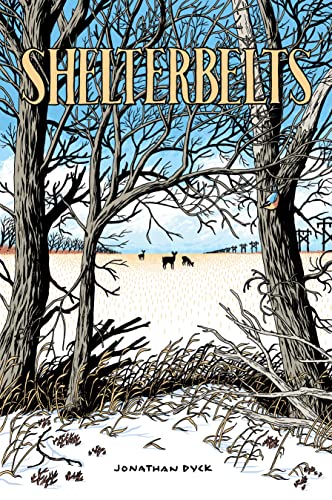![]() Shelterbelts by Jonathan Dyck
Shelterbelts by Jonathan Dyck
 With Shelterbelts, Jonathan Dyck joins the ranks of other great Canadian comic book creators such as Seth and Jeff Lemire, who both write and draw their own works. Shelterbelts is a sensitive book about a Mennonite town undergoing changes. We get glimpses of different parts of the community through a series of interrelated stories in which the same people show up in different contexts. For example, we meet the queer daughter of a Mennonite preacher in several stories, and we get to know the father who is wrestling with his church members over being more inclusive. Several of the members of the congregation leave to go to other churches.
With Shelterbelts, Jonathan Dyck joins the ranks of other great Canadian comic book creators such as Seth and Jeff Lemire, who both write and draw their own works. Shelterbelts is a sensitive book about a Mennonite town undergoing changes. We get glimpses of different parts of the community through a series of interrelated stories in which the same people show up in different contexts. For example, we meet the queer daughter of a Mennonite preacher in several stories, and we get to know the father who is wrestling with his church members over being more inclusive. Several of the members of the congregation leave to go to other churches.
One of the best stories is about a forty-year-old man who is a faithful Mennonite, yet he wrestles with his sexuality and attraction to men. We see him with his aging parents as they encourage him to find a woman. We watch him react negatively when he is approached by another man in a bar who asks for his name and phone number after sharing drinks together, and we see him deal with the rejection from his church when he wants to act as a youth leader on a church trip. The rejection is couched in an allusion to his making some kind of confession when he used to be a youth camp leader, a confession perhaps linked to homosexuality. We get glimpses of his past with panels displaying his time as a young man at the camp and the time he was accused of looking too much and too often at a male lifeguard. This past moment seems to be one that lingers in his mind. Overall, his story is my favorite, and it is written and drawn with nuance.
The story includes other narratives: There’s much talk about a pipeline that is going in on farmland, and there is frequent references by characters in the book to the fact that the Mennonite farmland was originally taken from the native population. In one scene, a woman returns to a farm that was once owned by her parents. There with her boyfriend, she gets into an argument with the new owner of the farm over his allowing the pipeline to go in. There’s also constant discussion of the new megachurch and its impact on the community. We meet members of a wide variety of churches, with people with different types of religious belief. We see witnesses to God go house to house, we see a couple break up as a young woman becomes more religious and her boyfriend reacts negatively to her newfound passion for God and church. Another great discussion takes place when a schoolteacher runs into a deer and is taken in for the night by an aging couple nearby when her car runs into a ditch after hitting the deer. The three of them talk in-depth about conscientious objectors and their history in the Mennonite church.
The artwork, too, is equally well-done. The black-and-white drawings are beautiful, particularly the attention to the natural world. The art also shows nature being damaged by oil companies and other entities. For example, the megachurch is critiqued for expanding and tearing up more of the land for recreational facilities and a coffee shop. I like the way Dyck uses series of panels to give us glimpses of setting, often including wordless panels for this purpose. For a first graphic novel by an artist, this is an accomplished work of art that I hope finds a wide audience. Shelterbelts is a wonderful example of the slice-of-life graphic novel, and it is well-paced, with room to breathe offering fully developed, in-depth conversations among the characters in the book. Readers of thought-provoking literature will want to seek out a copy of this book. Highly recommended.



We’re in total agreement David!
I felt just the same. The prose and character work was excellent. The larger story was unsatisfying, especially compared to…
Hmmm. I think I'll pass.
COMMENT Was I hinting that? I wasn't aware of it. But now that you mention it.... 🤔
So it sounds like you're hinting Fox may have had three or so different incomplete stories that he stitched together,…